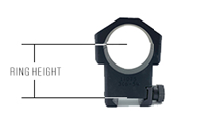How to Choose Scope Rings and Mounts: A Complete Guide
When deciding on an optic, consideration must be given to what mounts you can use to mount that optic. In saying that, best practice is to purchase the optic and then choose the mounts. Otherwise, it's like buying 4 sets of tyres and then buying a car to fit them.
Bases:
A Picatinny rail is the most common solution, as it allows for the simplest and most repeatable fitment. Being a universal standard, Picatinny rails make mounting scopes easy, as multiple different manufacturers make rings for this, as well as different heights, allowing for any multitude of combinations for height, tube size and application.
Dovetail rails are still a very common mounting system, but there are multiple different sizes and designs for these and thus not all rails are the same. Care must be taken to ensure that you are buying rings for the correct-sized dovetail that your rifle has on it.
Rings:
Selecting rings is the next step you need to take. Once you have the scope and the bases sorted, rings are a reasonably simple task. You need to figure out 4 things:- What base do I need (picatinny or dovetail)
- What tube size do I have (1", 30mm, 34mm, etc)
- What height do I need
- What material do I want (aluminium or steel)
What base do I need?
This is the simplest question: do you have a pic rail or a dovetail?
Fairly simple question to answer.
What tube size do I have?
The answer to this is dependent on the scope you have. There are multiple different tube sizes, and rings must be matched to the tube; otherwise, they will not fit. The easiest way to find this out is to look at the box of the scope or its listing online, and it will tell you. Otherwise, you can check the tube size yourself with a calliper with the tube on either side of the turret housing.
What height do I need?
This is the part that most people get stuck on. When considering scope height, it is easiest to work out how much you need to add in the rings. Most pic rail rings will display their height as from the top of the pic rail to the centre of where the tube will sit.
For example:
Dovetail works similarly, but from the top of the dovetail to the centre of the ring. This is generally true for both pic rail and dovetail, unless stated otherwise, but for the most part, most manufacturers will follow this.
Working out how much height to add in the ring can be a little bit convoluted, but I'll try to simplify it for you. The easiest way is to get the objective and half it. You will need to use the external diameter of the objective for this. For example, a Vortex Strike Eagle 5-25x56 has an external diameter of 63.5mm. 63.5mm divided by 2 = 31.75mm. This will be correct for dovetail rings, as there is no base to take into account with this. With a picatinny rail, you would subtract the base height from the required amount in the ring. Most picatinny rails are 5-10mm thick. For example, a Vortex Strike Eagle 5-25x56 (63.5mm external) would need at least 31.75mm height in the rings, and the rail would provide at least 5-10mm of height. Requiring at least 26.75-21.75mm in the rings. You would need to get more height than this calculation provides, as this calculation only provides the absolute minimum amount required. You will need to have more height than this to allow the scope to clear the barrel, so it does not become damaged.
What material do I want?
The main materials you can get in terms of scope rings are aluminium or steel. Aluminium rings are generally lighter, more available, rust-resistant and durable for most uses. Steel rings are heavier but stronger and able to handle more stress, but can be susceptible to rust.
Summary:
When it comes to choosing rings, there are a very large number of options, but once you follow the above steps, the process does get easier. If you still have any questions, please don't hesitate to contact the team at Optics Warehouse.







